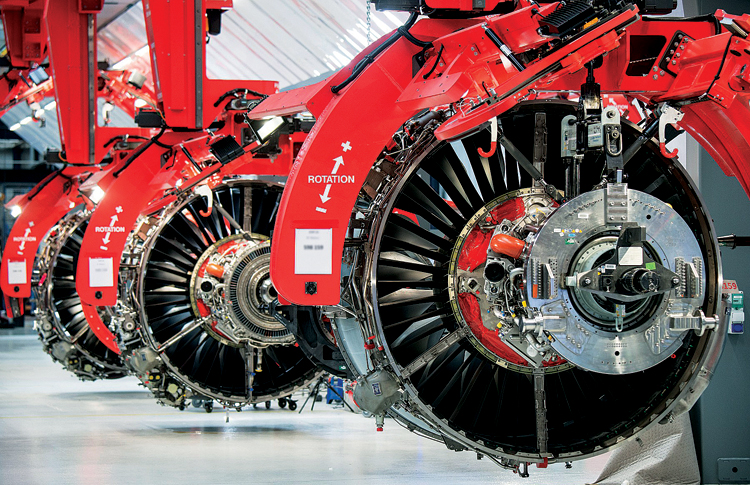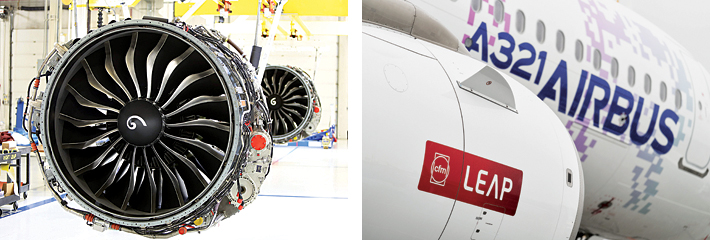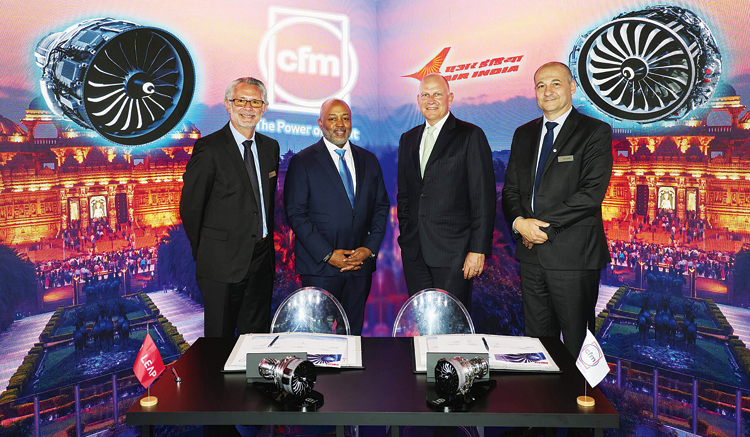INDIAN ARMED FORCES CHIEFS ON OUR RELENTLESS AND FOCUSED PUBLISHING EFFORTS

The insightful articles, inspiring narrations and analytical perspectives presented by the Editorial Team, establish an alluring connect with the reader. My compliments and best wishes to SP Guide Publications.

"Over the past 60 years, the growth of SP Guide Publications has mirrored the rising stature of Indian Navy. Its well-researched and informative magazines on Defence and Aerospace sector have served to shape an educated opinion of our military personnel, policy makers and the public alike. I wish SP's Publication team continued success, fair winds and following seas in all future endeavour!"

Since, its inception in 1964, SP Guide Publications has consistently demonstrated commitment to high-quality journalism in the aerospace and defence sectors, earning a well-deserved reputation as Asia's largest media house in this domain. I wish SP Guide Publications continued success in its pursuit of excellence.
- The layered Air Defence systems that worked superbly, the key element of Operation Sindoor
- Operation Sindoor | Day 2 DGMOs Briefing
- Operation Sindoor: Resolute yet Restrained
- India's Operation Sindoor Sends a Clear Message to Terror and the World – ‘ZERO TOLERANCE’
- Japan and India set forth a defence cooperation consultancy framework, talks on tank and jet engines
50 Million LEAP
The CFM LEAP engine family achieves 50 million flight hours, setting new standards in fuel efficiency, reliability, and sustainability in global aviation

The CFM LEAP engine family celebrated a significant milestone in April this year, achieving 50 million flight hours across more than 3,000 aircraft operated by over 150 airlines globally. Since its entry into service in 2016, the LEAP engine, designed for the Airbus A320neo, Boeing 737 MAX, and COMAC C919 passenger jets, has consistently delivered on its promises of enhanced fuel efficiency, reduced noise, and lower CO2 emissions. This has enabled operators to achieve higher aircraft utilisation rates. Compared to its predecessor, the CFM56 engine, the LEAP engine offers a 15 per cent to 20 per cent improvement in fuel efficiency and boasts best-in-class departure reliability rates.
Produced by CFM International, a joint venture between GE Aerospace and Safran Aircraft Engines, the LEAP engine’s impressive double-digit fuel efficiency gains allow aircraft to fly farther on a single tank of fuel while significantly reducing carbon and nitrogen oxide emissions. The advanced LEAP engine family sets new industry standards for fuel efficiency and asset utilisation, providing substantial improvements in fuel consumption, CO2 emissions, and noise levels.
Since its introduction, the LEAP engine has enabled operators to save more than 15 million tonnes of CO2. The LEAP-1A, LEAP-1B, and LEAP-1C models have all been jointly certified by the European Union Aviation Safety Agency (EASA) and the Federal Aviation Administration (FAA). The LEAP engine family is considered CFM’s most sustainable, with fuel usage 66 per cent lower than driving the same distance and up to a 20 per cent improvement in fuel and CO2 emissions.

(RIGHT) CFM LEAP-1A-POWERED A321XLR.
The LEAP engine is renowned for its rigorous testing, relentless focus on reliability, and use of revolutionary materials. These include additively manufactured (3D-printed) parts such as fuel nozzle tips, turbine shrouds made of ceramic matrix composites (CMCs), and 3D-woven carbon-fiber composites in the fan blades and case. The engine’s second-generation twin-annular, Premixing Swirler Combustor (TAPS II) reduces NOx emissions by 50 per cent compared to CAEP/6 standards. Unlike traditional combustors that mix fuel and air inside the combustion chamber, the LEAP nozzle pre-mixes these elements to achieve lean burn combustion. Additionally, the LEAP debris rejection system provides superior erosion protection, preventing sand, dirt, and other harmful particles from reaching the engine core, resulting in a highly durable and efficient engine that remains newer for longer.
THE CFM LEAP’S HIGHLIGHTS
Since its revenue service launch in August 2016, the LEAP engine has seen widespread adoption, with more than 4,000 engines in service across six continents as of June 2022 and 9,700 engines on order. This robust adoption highlights the LEAP engine’s significant contributions to advancing aviation sustainability and efficiency.
Enhancing Engine Health Monitoring with Machine Learning. Recently, as the LEAP engine fleet approached the 50 million flight hour milestone, CFM International expanded its engine health monitoring capabilities with machine learning to provide operators with more accurate insights than ever before.
David Harper, Fleet Support Director for GE Aerospace, further emphasised the benefits, “Combining this health monitoring system with our global CFM fleet support team has resulted in a 60 per cent earlier lead time in identifying preventative maintenance recommendations, a 45 per cent increase in detection rates, and a 50 per cent reduction in false alerts over the past decade.”
The advanced system models data from multiple engine sensors during takeoff, climb, and cruise, using probabilistic diagnostic and prognostic tools to generate targeted alerts based on known engine operating signatures. This sophisticated approach has led to earlier detection of potential issues, significantly improving operational reliability.
Agathe Venard, Head of Fleet Data Engineering, highlighted the impact of these advancements, “These state-of-the-art analytics provide LEAP operators with the data they need to make informed, insightful decisions about fleet management, ensuring a level of fleet stability that is crucial for day-to-day operations.”
The LEAP Promise. CFM International initially promised significant improvements in fuel efficiency, noise reduction, and CO2 emissions with the LEAP engine. “Eight years into service, CFM appears to have underpromised and overdelivered,” the manufacturer marks. The company states that not only has the LEAP engine maintained a 15 per cent to 20 per cent improvement in fuel efficiency over its immediate predecessor (the CFM56 engine) but it has racked up a 99.95 per cent departure reliability rate. To date, nearly 8,000 LEAP engines have been delivered, with over 10,000 engines on order.

Meeting Maintenance Demands. To support the extensive LEAP engine fleet, CFM has developed an open Maintenance, Repair, and Overhaul (MRO) ecosystem. This approach fosters market competition, incentivising MRO providers to invest in their facilities, which leads to competitive pricing and improved turnaround times. This ecosystem offers LEAP customers a variety of maintenance options, from standard line maintenance to full-performance restoration shop visits (PRSVs).
CFM’s internal network includes eight shops operated by GE Aerospace and Safran Aircraft Engines, along with 10 on-site support bases worldwide, providing quick turn maintenance solutions. “The LEAP engine design is stable, and we’ve significantly reduced the maintenance burden since its entry into service,” said Karl Sheldon, LEAP programme General Manager at GE Aerospace.
Innovations and Support. CFM continues to innovate with the introduction of an improved high-pressure turbine (HPT) blade design in 2024, aimed at minimising early engine removals, particularly in hot and harsh environments. Additionally, CFM has recently introduced a reverse bleed system (RBS) for the LEAP-1A engines, designed to reduce on-wing fuel nozzle replacements due to carbon deposit buildup. This system circulates cooling air through the engine core, preventing carbon deposits and reducing maintenance needs. “The RBS is a testament to our teams’ ingenuity, offering a solution that minimises maintenance burden and integrates seamlessly with existing aircraft systems,” said Gaël Méheust, President and CEO of CFM International.
Beyond its MRO ecosystem, CFM provides round-the-clock customer support with 250 field service engineers stationed globally and call centers in Paris, Shanghai, Bengaluru, and Cincinnati, ensuring comprehensive technical assistance for its customers.
LEAP ENGINES POWERING THE FUTURE OF INDIAN AVIATION
Indian airlines have also continued to rely on the CFM LEAP engines to power their fleets, marking a significant shift towards more efficient and sustainable aviation technologies.
- At the beginning of this year, Akasa Air and CFM International entered into a landmark agreement to purchase CFM LEAP-1B engines for 150 Boeing 737 MAX airplanes. This partnership builds on Akasa Air’s 2021 announcement to utilise LEAP-1B engines for its Boeing 737 MAX fleet.
- Air India has also made a substantial commitment to CFM LEAP engines, finalising an order to power its new fleet of 210 Airbus A320/A321neos and 190 Boeing 737 MAX family aircraft. This significant order, first announced in February 2023, included 800 LEAP engines: 420 LEAP-1A and 380 LEAP-1B, along with spares. Additionally, Air India and CFM International had signed a multi-year services agreement covering the airline’s entire fleet of LEAP engines, ensuring long-term operational support and reliability.
- In 2021, IndiGo selected CFM International’s LEAP-1A engines for its extensive fleet of 310 new Airbus A320neo, A321neo, and A321XLR aircraft. This agreement not only secured the LEAP-1A engines but also included long-term service agreements for a total of 590 IndiGo A320neo family aircraft.
The trend among Indian airlines to adopt CFM LEAP engines reflects a broader industry shift towards more efficient and environmentally friendly aviation solutions. With their advanced design and proven reliability, LEAP engines promise to enable airlines to achieve better fuel efficiency, reduced emissions, and higher aircraft utilisation rates. These partnerships are poised to transform the landscape of Indian aviation, setting new standards for operational excellence and sustainability.
LEAP’s remarkable achievement underscores the engine’s pivotal role in advancing the aviation industry towards a more sustainable future. The CFM LEAP engine continues to redefine aviation standards with its groundbreaking performance, reliability, and sustainability. With a growing order book, the LEAP engine is poised to further its impact on the industry. As the CFM LEAP engine family continues to set new standards in aviation, its advancements in machine learning for health monitoring and ongoing innovations ensure that it remains at the forefront of the industry, providing reliable and efficient solutions for commercial aviation.





